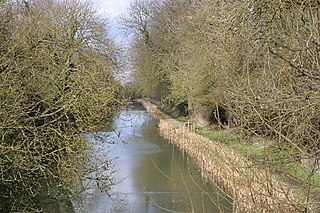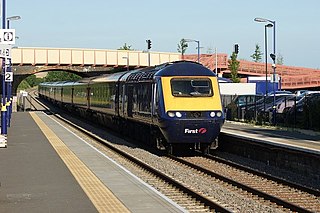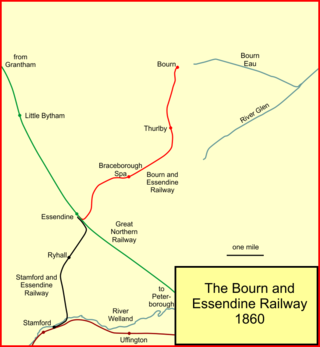
Bourne is a market town and civil parish in the South Kesteven district of Lincolnshire, England. It lies on the eastern slopes of the limestone Kesteven Uplands and the western edge of the Fens, 11 miles (18 km) north-east of Stamford, 12 miles (19 km) west of Spalding and 17 miles (27 km) north of Peterborough. The population at the 2011 census was 14,456. A 2019 estimate put it at 16,780.

The Midland and Great Northern Joint Railway (M&GNJR) was a railway network in England, in the area connecting southern Lincolnshire, the Isle of Ely and north Norfolk. It developed from several local independent concerns and was incorporated in 1893. It was jointly owned by the Midland Railway and the Great Northern Railway, and those companies had long sponsored and operated the predecessor companies.

Northampton railway station serves the county town of Northampton in England. It is on the Northampton Loop of the West Coast Main Line. The station is served by West Midlands Trains services southbound to London Euston and northbound to Birmingham New Street and Crewe. A handful of Avanti West Coast services also serve the station, however, these have been greatly reduced due to the impact of the COVID-19 pandemic in the United Kingdom.

Wymondham is a village in the Borough of Melton in Leicestershire, England. It is part of a civil parish which also covers the nearby hamlet of Edmondthorpe. The parish has a population of 623, increasing to 632 at the 2011 census. It is close to the county boundaries with Lincolnshire and Rutland, nearby places being Garthorpe, Teigh and South Witham.

Castle Bytham is a village and civil parish of around 300 houses in South Kesteven, Lincolnshire, England. It is located 9 miles (14 km) north of Stamford and 9 miles (14 km) west of Bourne.The population was measured at 768 in 317 households at the 2011 census.

The Oakham Canal ran from Oakham, Rutland to Melton Mowbray, Leicestershire in the East Midlands of England. It opened in 1802, but it was never a financial success, and it suffered from the lack of an adequate water supply. It closed after 45 years, when it was bought by the Midland Railway to allow the Syston and Peterborough Railway to be built, partly along its course. Most of it is infilled, although much of its route can still be seen in the landscape, and there are short sections which still hold water.

Honeybourne railway station serves the village of Honeybourne in Worcestershire, England. Opened in 1853, it is on the Cotswold Line and was formerly a busy junction with five platform faces, also serving trains on the Great Western Railway's Honeybourne Line between Cheltenham Spa and Stratford-upon-Avon, which formed part of a strategic route between the West Midlands and the West of England.

The A6121 is a short cross-country road in the counties of Lincolnshire and Rutland, England. It forms the principal route between Bourne and Stamford and the A1 in Lincolnshire, continuing on through Ketton in Rutland to its junction with the A47 at Morcott. Its south-western end is at 52°35.5860′N0°38.0820′W and its north-eastern end is at 52°45.9120′N0°24.0660′W. The road has increased in importance with the rapid expansion of housing in this part of South Kesteven.

Toft is a small village in the South Kesteven district of Lincolnshire, England. It is situated approximately 2 miles (3 km) south-west from Bourne on the A6121. Toft is part of the civil parish of Toft with Lound and Manthorpe. The population of the civil parish at the 2011 census was 333.

Lowestoft North railway station was in Lowestoft, England. It closed in 1970.

Twenty railway station served the village of Twenty, Lincolnshire. It was on the route of the Spalding and Bourne Railway, later part of the Midland and Eastern Railway and then part of the Midland and Great Northern Joint Railway main line between the Midlands and the Norfolk Coast.

Bourne was a railway station serving the town of Bourne in Lincolnshire, which opened in 1860 and closed to passengers in 1959.

Castle Bytham railway station was a station in Castle Bytham. It was Midland Railway property but train services were operated by the Midland and Great Northern Joint Railway (M&GN). The station and line closed in 1959 along with most of the M&GN.

Saxby railway station was a station serving the villages of Saxby and Freeby, Leicestershire. It was located between the two villages.

Luffenham railway station is a former station of the Syston and Peterborough Railway serving the villages of North and South Luffenham, Rutland.
The Syston and Peterborough Railway was an early railway in England opened between 1846 and 1848 to form a connection from the Midland Counties Railway near Leicester to Peterborough, giving access to East Anglia over the Eastern Counties Railway. The project was part of the ambition of George Hudson to establish and maintain a monopoly of railway service over a large area of England. The surveying of the line achieved notoriety when Robert Sherard, 6th Earl of Harborough, who was hostile to railways, arranged a battle to obstruct surveys of the proposed line, and later of its construction.

Broom Junction was a railway station serving the village of Broom in Warwickshire, England. It was an interchange for both the Stratford-upon-Avon and Midland Junction Railway and the Barnt Green to Ashchurch line.

Stapleford Park is a Grade I listed country house in Stapleford, near Melton Mowbray in Leicestershire, England, which is now used as a hotel. It was originally the seat of the Sherard and Tamblyn families, later the Earls of Harborough and, from 1894, of the Gretton family, who would become the Barons Gretton.
Laverton Halt railway station was a halt on the Honeybourne Line from Honeybourne to Cheltenham which served the hamlet of Laverton in Gloucestershire between 1905 and 1960.

The Bourn and Essendine Railway was a seven mile long branch line which connected Bourne in Lincolnshire to the East Coast Main Line in the village of Essendine in Rutland. The line was opened in 1860; it was a single line and served the town of Bourne and the villages of Thurlby, Braceborough and Essendine. Its line ran through the ceremonial counties of Lincolnshire and Rutland in the East Midlands of England.


















